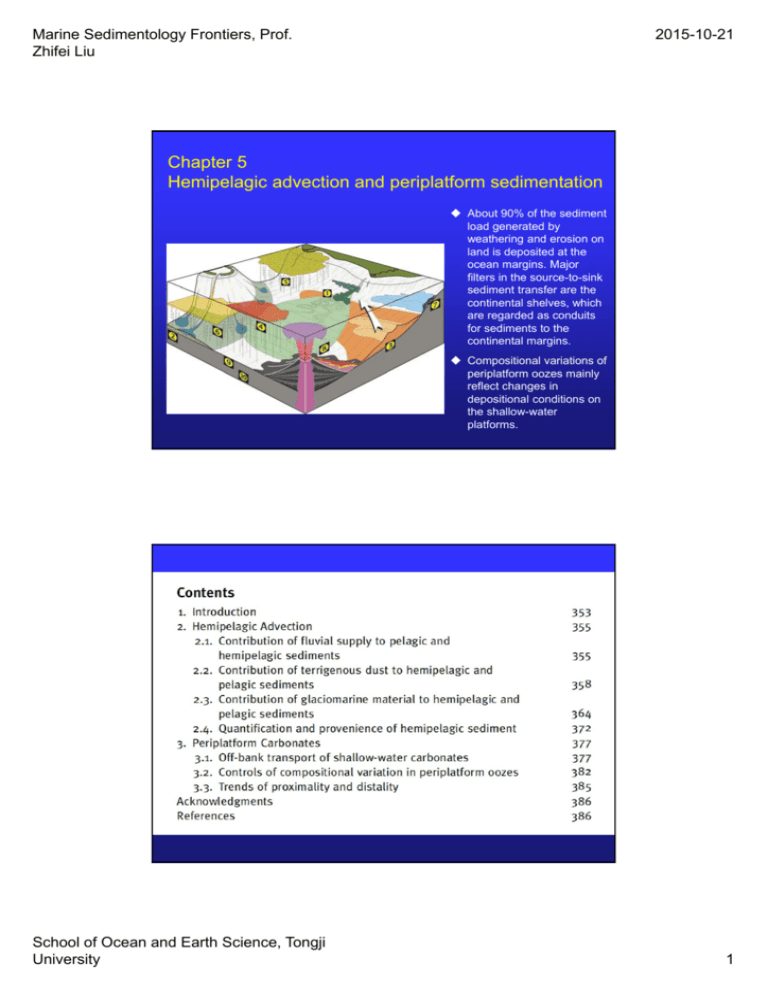Chapter 5 Hemipelagic advection and periplatform sedimentation
advertisement

Marine Sedimentology Frontiers, Prof. Zhifei Liu 2015-10-21 Chapter 5 Hemipelagic advection and periplatform sedimentation About 90% of the sediment load generated by weathering and erosion on land is deposited at the ocean margins. Major filters in the source-to-sink sediment transfer are the continental shelves, which are regarded as conduits for sediments to the continental margins. Compositional variations of periplatform oozes mainly reflect changes in depositional conditions on the shallow-water platforms. School of Ocean and Earth Science, Tongji University 1 Marine Sedimentology Frontiers, Prof. Zhifei Liu 2015-10-21 1. Contribution of fluvial supply In many regions of the ocean, river supply is by far the most important contributor of terrigenous material. The amount of sediment supplied by rivers has been shown to the proportional to the surface area of the drainage basin. It also depends on uplift rates and the climate. Diffusive transport (by waves and tides) and advective (by currents) transport are assumed to control the mud distribution on the margins, and gravity-driven flows are thought to be important for moving sediment down the continental slope. Fine-grained fluvial sediment dispersal systems: estuarine accumulation-dominated (EAD), canyon-captured (CC), proximal accumulation-dominated (PAD), marine dispersal-dominated (MDD) and subaqueous delta clinoform (SDC) systems. Frequency, size and distribution of various dispersal systems strongly depend on shelf geometry and oceanography. Fluvial freshwater discharge (Milliman and Farnsworth, 2011) School of Ocean and Earth Science, Tongji University 2 Marine Sedimentology Frontiers, Prof. Zhifei Liu 2015-10-21 Fluvial sediment discharge (Milliman and Farnsworth, 2011) Sediment discharge from Taiwan (Dadson et al., 2003) School of Ocean and Earth Science, Tongji University 3 Marine Sedimentology Frontiers, Prof. Zhifei Liu 2015-10-21 Marine dispersal-dominated (MDD) in the Taiwan Strait (from Liu JP et al., 2008) School of Ocean and Earth Science, Tongji University 4 Marine Sedimentology Frontiers, Prof. Zhifei Liu 2015-10-21 2. Contribution of terrigenous dust In arid and semi-arid tropical and subtropical ocean provinces, dust supply is by far the most important terrigenous contribution to pelagic and hemipelagic sedimentation. Saharan dust is regularly transported from its source areas along three main transport paths: westward over the North Atlantic Ocean, northward across the Mediterranean to Europe, and along easterly trajectories across the eastern Mediterranean. Long-distance transport of central Asian dust by the westerly jet results in it crossing the Pacific in 12-18 days. With respect to supply rates, the Sahara is the most important source region, export estimates being 0.6-0.7 Pg/a, whereas Asian dust transport rates into the North Pacific are two orders of magnitude lower. The hyper-arid core region of the Sahara expanded during glacials, while dust export to the ocean significantly increased, and deposition of aeolian sand turbidites occurred on the slope. School of Ocean and Earth Science, Tongji University 5 Marine Sedimentology Frontiers, Prof. Zhifei Liu School of Ocean and Earth Science, Tongji University 2015-10-21 6 Marine Sedimentology Frontiers, Prof. Zhifei Liu 2015-10-21 3. Contribution of glaciomarine material Sea ice, continental ice sheets and their outlet glaciers influence the pelagic realm and atmospheric circulation fundamentally. Mechanisms incorporating sediment into sea ice include: Aeolian transport; in shallow shelf regions: stirring up, re-suspension and freeze-in of fine-grained terrigenous sediments; in near coastal areas: river discharge onto sea ice and rock fall from cliffs. Icebergs release sediments of all grain sizes, sorting classes and composition. In most cases, the iceberg sediments contain large amounts of terrigenous coarse material, called “ice-rafted debris (IRD)”. Quantitative studies from the Nordic seas have shown that IRD contents can be correlated to the onshore glacial history. However, in the Antarctic region, extensive ice-shelf environments developed under extreme polar aridity, resulting in generally low sedimentation rates on the shelf and slope because of very restricted meltwater production and supply of IRD. School of Ocean and Earth Science, Tongji University 7 Marine Sedimentology Frontiers, Prof. Zhifei Liu School of Ocean and Earth Science, Tongji University 2015-10-21 8 Marine Sedimentology Frontiers, Prof. Zhifei Liu School of Ocean and Earth Science, Tongji University 2015-10-21 9 Marine Sedimentology Frontiers, Prof. Zhifei Liu 2015-10-21 4. Quantification and provenience Grain-size spectra of the suite of remaining terrigenous particles after removing organic, carbonate and opal fractions, were frequently used to decipher the variable input sources and transport modes. Three basic types of current-influenced sediments can be distinguished: (1) sediments deposited by low-energy processes; (2) sediments representing remnants of erosional processes; (3) wellsorted sediments. “Sortable silt”: terrigenous 63-10 m fractions, its mean grain size as an indicator for the deep-ocean current strength. “Koopmann index”: relationship between the modal grain size of terrigenous fraction (>6 m) and the proportion of this fraction relative to the bulk sediment, to distinguish between aeolian and fluvial sediment supply and current sorting. Clay minerals are considered as another important terrigenous proxy in deep-sea sediments. School of Ocean and Earth Science, Tongji University 10 Marine Sedimentology Frontiers, Prof. Zhifei Liu 2015-10-21 McCave and Hall (2006, G3) School of Ocean and Earth Science, Tongji University 11 Marine Sedimentology Frontiers, Prof. Zhifei Liu 2015-10-21 5. Periplatform carbonates Pelagic sediments gradually merge into carbonate oozes that include a growing proportion of shallow-water carbonate debris and mud. Off-bank transport of coarse-grained material from carbonate platform occurs mainly during the passage of storms along open leeward bank margins. Compositional variations in periplatform oozes mainly reflect changes in depositional conditions on the shallow-water platforms. Impact of both sea-level fluctuations and climatic changes on the accumulation patterns of periplatform sediments is high. Compositional variations also depends on the orientation of carbonate platform with respect to the prevailing wind direction and its type of margin setting. Response to glacial/interglacial changes, reverse correlations in grain-size distribution patterns have been recognized. School of Ocean and Earth Science, Tongji University 12 Marine Sedimentology Frontiers, Prof. Zhifei Liu School of Ocean and Earth Science, Tongji University 2015-10-21 13 Marine Sedimentology Frontiers, Prof. Zhifei Liu School of Ocean and Earth Science, Tongji University 2015-10-21 14






